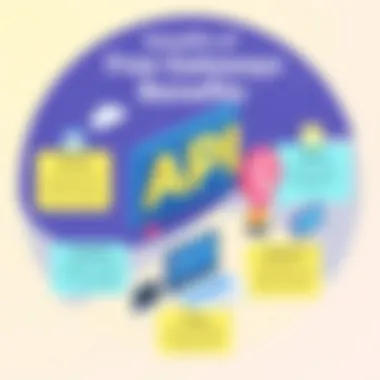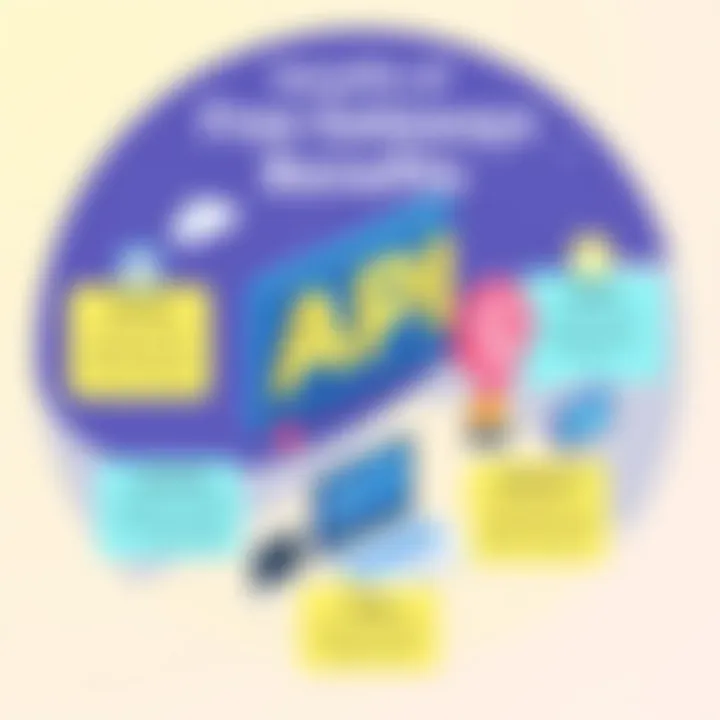A Thorough Look at Free API Gateways' Benefits


Intro
In the rapidly evolving realm of software development, the integration of multiple systems has become not merely important, but essential. This brings us to a significant player in this field: free API gateways. Understanding their functionality is crucial for both IT and software professionals seeking to enhance operational efficiency. But what exactly does an API gateway do, and why is it vital for businesses?
API gateways function as intermediaries between different systems, channeling requests and responses seamlessly. Just imagine a translator at an international conference, ensuring that communication flows smoothly without any hitches. They streamline the process, reduce complexity, and allow different applications to communicate effectively. This not only speeds up the development act but also enhances performance, making organizations leaner and more agile.
In this article, we will engage in a thorough exploration of free API gateways, touching on their benefits and limitations. We will delve into prominent choices, evaluate performance metrics, and unearth best practices. The insights here are tailored to professionals who might be sifting through options to improve their systems, whether they're running a small startup or a large enterprise.
Let’s embark on this journey and uncover the full potential of free API gateways.
Preface to API Gateways
In the age of digital transformation, the role of API gateways emerges as vital. They serve as crucial intermediaries that facilitate communication between various software applications. By doing this, they streamline complex processes and improve performance, allowing businesses to operate more efficiently. Understanding what API gateways are and their underlying features is essential for any organization looking to enhance its software integration strategies.
What is an API Gateway?
An API gateway is fundamentally the entry point for managing requests from clients to backend services. It plays the role of a traffic controller, ensuring that requests are processed efficiently and routed to the appropriate destinations. At its core, an API gateway handles tasks such as authentication, routing, and rate limiting. Without a well-functioning API gateway, a system can easily become disorganized, leading to delays and potentially crippling downtime.
The significance of an API gateway extends beyond mere request handling. It accumulates data on traffic and performance, helping teams better understand usage patterns and optimize their services. It essentially centralizes control over access and security, establishing a barrier against malicious activities.
Importance of API Management
Effective API management is not merely about having a robust gateway; it's about ensuring that the APIs serve their intended purpose seamlessly. API management provides the framework necessary to give developers and businesses the tools to maximize API potential. This encompasses everything from access controls to usage analytics. Key benefits of effective API management include:
- Improved Security: By managing access and providing authentication protocols, organizations can better protect sensitive data.
- Enhanced Performance: With capabilities like caching and load balancing, businesses can speed up response times.
- Better Visibility: Monitoring capabilities provide insights into traffic and user behavior, helping in strategic decision-making.
Proper API management is like having a well-oiled machine; everything needs to work in harmony for optimal output.
Despite these advantages, API management also demands careful consideration of factors like scalability and the evolving technology landscape. Organizations must stay aware of their specific needs as they navigate the complexities of integrating APIs into their business models. Understanding the importance of API gateways and management is the first step toward leveraging these tools successfully.
The Concept of Free API Gateways
In today’s fast-paced digital world, where integration is crucial for business success, understanding the concept of free API gateways becomes imperative. These gateways serve as the interface between different applications, allowing them to communicate and share data seamlessly. While many might think that free solutions lack quality, the reality is that these gateways can offer invaluable features that are suitable for a variety of projects, from startups to large enterprises. The accessibility they provide plays a key role in fostering innovation and reducing costs.
Defining Free API Gateways
Free API gateways can be characterized as open-source or freely available tools that facilitate API management. They provide essential capabilities such as traffic management, security, and statistics monitoring without the user facing any financial barriers. Essentially, they act as middlemen between the client and servers, handling requests and responses efficiently.
When we look at the definition, important aspects come to light:
- User-Friendly Interface: Many gateways are designed with simplicity in mind, allowing developers to integrate them without mountains of documentation.
- Community-Driven Development: Free gateways often evolve due to community input, which can lead to rapid advancements and feature enhancements.
The very nature of free API gateways encourages collaboration and experimentation. As developers test and utilize these tools, they end up providing feedback, thus helping to shape the system in a way that paid solutions might not accommodate due to commercial constraints.
How Free API Gateways Differ from Paid Solutions
When comparing free API gateways to their paid counterparts, some significant distinctions become apparent. Here’s a run-through of the primary differences:
- Cost Structure: As the name suggests, free gateways impose no initial costs, making them attractive for startups and small businesses eager to minimize expenses. In contrast, paid solutions typically charge fees based on the volume of requests or offer tiered pricing based on features.
- Feature Set: Paid gateways may come bundled with advanced features that are absent in free versions. For example, capabilities like automated scaling, detailed analytics, and enhanced support options can be better developed in the paid alternatives.
- Reliability and Support: Service guarantees and support levels vary widely. Free gateways may rely heavily on community forums and user-generated knowledge bases, while a paid solution generally ensures professional support.
- Scalability: Although free API gateways can handle a reasonable amount of traffic, they might face performance bottlenecks as demand increases. Paid options often come with the advantage of consistent performance at scale.
In summary, while free API gateways come with a different set of trade-offs compared to paid options, their appeal lies in their accessibility and adaptability, making them invaluable in various contexts, especially where budgets are a primary concern. > "The essence of free API gateways lies in flexibility, ensuring that users can experiment, customize, and optimize their integration needs without financial constraints." - Industry Expert
Core Features of Free API Gateways
Free API gateways serve as crucial components in today's software ecosystems, enabling seamless integration of various services while providing essential functionalities. There are specific aspects that stand out in the architecture of these gateways, greatly impacting their performance and utility. These features not only enhance the user experience but also play a vital role in managing the traffic that flows through APIs. Here, we will delve into three pivotal features: Routing and Load Balancing, Security Protocols, and Monitoring and Analytics.
Routing and Load Balancing
Routing is one of the fundamental tasks that an API gateway performs. It directs requests to the appropriate backend services based on the information imbued in the request. The efficiency of routing is paramount, especially in complex applications requiring interaction between multiple services. Free API gateways often leverage different routing algorithms which can be based on factors such as request type, user access level, or other custom parameters.
Load balancing complements routing by distributing incoming requests evenly across multiple servers or services. This ensures that no single resource is overwhelmed, enhancing the overall responsiveness and uptime of applications. For instance, when a query comes in, a gateway can direct it to the server with the least load, preventing bottlenecks.
"Effective routing and load balancing are not just luxury features; they are necessities for maintaining application performance and reliability."


Security Protocols
In an era where data breaches make headlines, security cannot be an afterthought. Free API gateways incorporate various security protocols that form a protective layer around APIs, minimizing vulnerabilities. Common implementations include OAuth for authorization, which allows third-party applications to access user data without exposing credentials. SSL/TLS encryption is also standard; it secures data in transit by encrypting the information passed between client and server.
Moreover, gateways often utilize rate limiting and IP whitelisting to shield from malicious attacks such as DDoS (Distributed Denial of Service) attacks. Rate limiting restricts the number of calls a user can make in a given timeframe, effectively curbing resource misuse.
Monitoring and Analytics
Monitoring is indispensable when it comes to assessing the health and performance of APIs. Most free API gateways provide built-in analytics features that allow organizations to track key metrics such as response times, error rates, and usage patterns. By analyzing this data, IT teams can identify potential issues before they escalate into major problems, enabling proactive maintenance.
Analytics also offer insights into user behavior, guiding businesses in refining their offerings. For instance, if a specific endpoint is receiving an unusually high volume of requests, it may indicate a feature that users find particularly useful, or it could point to an emerging problem needing attention.
Advantages of Utilizing Free API Gateways
Free API gateways offer a multitude of benefits that can significantly enhance both operational efficiency and software integration processes. Understanding these advantages is critical for organizations aiming to optimize their digital infrastructures without taxing their budgets. Below, we delve into three primary advantages: cost efficiency, flexibility and customization, and access to community support.
Cost Efficiency
One of the most compelling reasons to adopt a free API gateway is the cost savings it offers. In a world where budgets for tech projects often seem tighter than a drum, utilizing a no-cost solution allows businesses to allocate resources to other critical areas. For instance, small startups can invest their savings into product development or marketing initiatives rather than on expensive API management tools.
Moreover, free API gateways often come with no hidden fees or surprise costs, which is a common pitfall in the subscription-based models of paid alternatives. This transparency aids in precise financial planning.
"With zero acquisition cost, free API gateways make it easier for teams to get up and running quickly, without the worry of how to recoup an upfront investment."
Flexibility and Customization
Another significant advantage of free API gateways is the flexibility they provide. Unlike their paid counterparts, many free solutions offer robust options for customization, allowing organizations to tailor functionalities to their specific requirements. This is pivotal as different industries often have unique workflows. For instance, a retail company may need to integrate with various payment processors, while a healthcare provider may focus on ensuring compliance with data protection regulations.
Furthermore, many free API gateways permit integration with multiple protocols, meaning teams can work within a familiar framework without the steep learning curve that comes with adopting new technologies. In practice, this translates to less downtime in training employees and a more streamlined integration process across systems.
Access to Community Support
Community support is another noteworthy benefit associated with free API gateways. Often, these platforms have active user communities that share their experiences, best practices, and troubleshooting tips. When an organization faces challenges using a particular gateway, turning to forums or community pages can often yield quick and effective solutions without needing to invest in expensive technical support.
Moreover, engaging with a community of users can drive innovation. Users often contribute their improvements or modifications back to the project, which enhances the capabilities of the gateway as a whole. This collaborative environment creates a sense of shared ownership and accelerates development, ensuring the tool remains relevant in a fast-evolving tech landscape.
In summary, the advantages of utilizing free API gateways are numerous and impactful. They not only alleviate financial constraints but also provide organizations with the flexibility to mold solutions to fit their needs. Engaging in community support enhances the overall experience, making these gateways a viable option for businesses eager to enhance their operational efficiency.
Limitations of Free API Gateways
While free API gateways offer several advantages, understanding their shortcomings is crucial for any IT professional or organization looking to leverage their capabilities. Limitations can significantly impact the performance and usability of your systems, and being forewarned is forearmed. In this segment, we break down the key limitations often associated with free API gateways, allowing you to make an informed choice that aligns with your business objectives.
Performance Constraints
One of the primary challenges of free API gateways lies in performance constraints. Although these solutions may serve your needs adequately during initial stages or lower traffic levels, they often falter under heavy load.
Issues such as:
- Rate limiting: Free gateways frequently impose strict limits on the number of requests per second, which can throttle performance during peak usage.
- Latency: Optimization is sometimes lacking, resulting in delayed response times, which can exacerbate user frustration.
- Scalability: Free options tend to offer limited scalability. As user demand grows, your service may not be able to adapt quickly, causing bottlenecks.
If you're not prepared for these performance pitfalls, your users might get a sour taste, and maintaining a seamless user experience becomes a juggling act.
Lack of Advanced Features
When you dive into the sea of free API gateways, you might find that you’re missing the boat on some advanced features that paid offerings come packed with. Critical components that can be absent include:
- Custom authentication mechanisms: While basic security protocols like API key management might be supported, more nuanced options such as OAuth 2.0 may not be available.
- Analytics and reporting tools: These would assist in tracking API usage effectively, but the lack of in-depth analysis can lead to poor decision-making due to insufficient data.
- Fine-grained control features: Such as IP whitelisting or blacklisting, which are vital for enterprise-level applications.
Each of these missed opportunities can lead to missed chances for growth or optimization down the line.
Support and Maintenance Challenges
Support is the backbone often overlooked when it comes to free API gateways. With limited funding for these tools, support channels can be sparse.
A few pitfalls include:


- Community Dependency: Many free services rely heavily on community support, which may not always be timely or effective, especially when urgent issues arise.
- Limited documentation: Often, the resources available are not as well-documented compared to their paid counterparts, leading to potential confusion for developers.
- Maintenance Issues: Without dedicated teams, the update and patch cycles might not be as frequent, leaving your system vulnerable to security risks.
"Free can be tempting, but if you can't get help when you need it, it can turn into more trouble than it’s worth." Ultimately, these limitations could hinder your operating efficiency and erode the confidence in the solutions you deploy.
To mitigate these issues, it becomes essential to carefully evaluate the free API gateways you consider, weighing the potential limitations against organizational needs, ensuring that both short-term and long-term objectives can be met effectively.
Popular Free API Gateways
In a world where businesses are continuously seeking to optimize their integration processes, the emergence of free API gateways has proven to be quite a game changer. Understanding which free API gateways are popular among developers and organizations can significantly influence efficiency and effectiveness in software projects. These tools not only aid in managing request traffic but also serve as guardrails for security, ensuring that data flows smoothly without compromising integrity.
These gateways facilitate connections between services, allowing a seamless interaction that's essential for both small startups and larger enterprises. They serve as a central point for API management, marshaling requests while parsing responses with finesse. Companies that opt for free solutions, particularly during tight budgeting periods, must navigate through various options to determine the best fit. This section takes a closer look at three of the most popular free API gateways: Kong, Tyk, and API Umbrella.
Kong
Kong is considered a heavyweight in the arena of free API gateways, primarily due to its robust features and flexibility. It operates as a platform for managing APIs, whether they are on-premises or in the cloud. Its microservices architecture simplifies scaling, allowing users to manage high traffic effortlessly.
One of the standout features of Kong is its plugin architecture. This allows organizations to easily add new capabilities without needing extensive development work. Users can choose from a plethora of plugins that cater to security, traffic control, and analytics among other functionalities. Moreover, the ease of integration with popular cloud services provides added advantages, especially for teams already embedded in the cloud ecosystem.
In addition, Kong’s dashboards and monitoring tools present critical metrics, ensuring teams can track usage effectively. This aids in performance tuning, making Kong not just a gateway but a thoroughfare for insights as well.
Tyk
Tyk distinguishes itself with its user-friendly interface and significant emphasis on developer experience. Smaller teams and businesses might find Tyk's focus on simplicity appealing, as it enables them to harness powerful features without a steep learning curve. Tyk's open-source version offers vital functionalities such as traffic management, user authentication, and detailed analytics.
Security is a crucial pillar of Tyk’s offerings. With built-in support for OAuth and various authentication mechanisms, it protects APIs while allowing authorized access seamlessly. Furthermore, Tyk encourages customization, letting teams tailor the API gateway to suit their needs.
Tyk also integrates smoothly with existing infrastructure, making it ideal for companies looking to enhance their current setups without extensive modifications. Overall, Tyk embodies a practical approach while delivering substantial capabilities.
API Umbrella
API Umbrella embraces a more holistic approach towards managing and distributing APIs. Designed to help organizations publish their APIs to both internal and external audiences, it offers a plethora of features tailored for various needs. This includes rate limiting, analytics, and API documentation tools.
A defining attribute of API Umbrella is its user interface, which prioritizes clarity. Users can navigate through features with relative ease, an important aspect for companies with varied technical expertise among staff. The built-in API documentation capabilities also enable organizations to keep their documentation updated and accessible, promoting greater interaction with users.
In parallel, API Umbrella supports multiple backend services, so businesses aren’t locked into one specific architecture. This level of versatility ensures organizations can adapt as their API ecosystems evolve.
In summary, Kong, Tyk, and API Umbrella each provide unique advantages, appealing to different types of organizations. When selecting amongst them, groups should consider not only current needs but also how each solution aligns with their long-term strategy and technical requirements.
Best Practices for Implementing Free API Gateways
When it comes to adopting free API gateways, understanding best practices isn't just a recommendation—it's essential. Navigating the landscape of free tools can feel akin to walking through a minefield; one wrong step can derail your project. Following best practices ensures that your integration is smooth, efficient, and compliant with organizational needs. This section will detail key strategies for successfully deploying free API gateways, emphasizing their significance in the broader context of software integration and operational efficiency.
Assessing Organizational Needs
Before diving headfirst into any API gateway, it's crucial to assess the specific needs of your organization. Different projects have different requirements, and a one-size-fits-all approach rarely yields optimal results. Start by asking the following questions:
- What are the primary objectives for implementing an API gateway?
- How many APIs will be managed through this gateway?
- What is the expected volume of traffic, and what scalability options are necessary?
Careful consideration of these aspects helps narrow down the choices. For instance, if you’re working in a small startup with limited resources, you may need a lightweight solution that emphasizes cost-effectiveness. Alternatively, a larger enterprise might require a more robust system that can handle complex integrations and high traffic volumes. Aligning your API gateway choice with business objectives is paramount to avoid unsatisfactory outcomes.
Monitoring Performance Metrics
Once you have selected and implemented your free API gateway, the real work begins. Monitoring its performance is not just a box-checking exercise; it's a proactive measure to ensure that your systems are running as designed. Some critical metrics to track include:
- Response Time: How quickly does the gateway process requests?
- Error Rates: Are there frequent failures, and what's causing them?
- Throughput: How many requests can be handled per second?
By establishing baseline performance metrics before implementation, you create a frame of reference that allows you to gauge the actual impact of your API gateway. Consistent monitoring can alert you to potential issues, enabling swift corrective action. As they say, "What gets measured gets managed." So don't overlook this crucial aspect.
Engaging with the Community
Part of the charm of using free API gateways is the vibrancy of their communities. Many of these tools are open-source, which means you have access to a wealth of knowledge. Engaging with the community can bring several advantages:
- Troubleshooting Help: Community forums and discussion boards are often filled with users who’ve faced similar challenges.
- Best Practices: Learn from the experiences of others to refine your approach to implementation.
- Feature Requests: Users often have a platform to suggest new features, which can influence future development.
Platforms like Reddit and GitHub can be incredibly useful for staying engaged. For example, participating in discussions on the Tyk subreddit might uncover hacks or tips that could save your team countless hours.


Engaging with the community isn’t just about seeking help; it's also about contributing back. Sharing your solutions or experiences helps create a harmonious exchange of information that benefits everyone. As you deepen your engagement, your understanding of tool capabilities expands, enhancing your organization's use of the free API gateway.
In summary, knowing your organizational needs, actively monitoring key performance metrics, and connecting with the community spells the difference between a successful implementation and a convoluted mess. With these strategies in mind, you are better positioned to harness the full potential of free API gateways for your projects.
Case Studies of Successful Implementations
In the realm of free API gateways, exploring real-world applications paints a clearer picture for organizations considering these tools. Case studies serve as vital proof points. They not only showcase how different entities leverage these systems but also offer valuable lessons learned along the way. Implementing an API gateway should not only rely on theoretical benefits but need to be backed by evidence from successful deployments. Cycle through these examples to understand the impact, functionalities, and potential challenges some organizations faced during their implementation journey.
Medium-Sized Enterprises
For medium-sized enterprises, agility and robustness are key. A notable example is a mid-tier eCommerce platform that adopted Kong as its free API gateway. Before the implementation, they grappled with issues like latency during high traffic periods, especially around promotional events. By adopting Kong, they streamlined API traffic management and significantly reduced latency by 40% during peak times. This sort of performance gain is often essential for enterprises wanting to keep their competitive edge.
One particular area worth noting is how the company leverages Kong’s admin interface for real-time monitoring, which allows them to make informed decisions regarding traffic routing and load balancing. Furthermore, broad community support around Kong ensured that they could tweak configurations quickly and resolve issues efficiently. Cost-wise, the operation was a win as well — the absence of hefty licensing fees meant more budget towards improving their product lines.
In summary, medium-sized businesses can rely on free API gateways like Kong to enhance their operational performance while maintaining flexibility.
Nonprofit Organizations
Nonprofits often work under tight budgets. A community-based health organization is a prime example of successfully implementing API Umbrella for streamlined operations. The organization faced hurdles in integrating multiple stakeholders, including healthcare providers, patients, and administrative staff. However, with API Umbrella, they established a centralized point for their data exchange, ensuring that communications remained seamless.
Given the nature of nonprofit work, data privacy and security are paramount. The organization utilized the in-built security protocols from API Umbrella to protect sensitive health data, without incurring further financial strain. From monitoring API calls to setting access levels for different users, the implementation allowed for fine-grained control over their digital resources.
Monitoring and feedback became another jewel in their crown. By leveraging API analytics, the nonprofit could gather insights into patient interactions with their platform, helping them tweak processes and improve user experience.
To sum up, nonprofit organizations benefit heavily from free API gateways. The combination of cost-effectiveness and robust features allows such entities to focus on their core mission while enhancing efficiency in service delivery.
“In both established businesses and charitable organizations, the focus is not merely on financial savings; it’s about investing in tools that enable growth, innovation, and enhanced service.”
Overall, the case studies demonstrate that irrespective of sector, free API gateways can effectively meet specific operational needs. From reducing latency in eCommerce to facilitating communication in non-profits, these platforms provide diverse solutions tailored to varied organizational challenges.
Future of Free API Gateways
The world of technology is like a fast-moving train, and free API gateways are definitely riding along on that stream. Their future is not just crucial for the individuals and enterprises employing them but for the broader landscape of software integration and digital services. As more organizations embrace digital transformation, the need to build and scale applications efficiently is surging. Free API gateways serve as the bridge between various applications, making them indispensable in this evolving environment.
Understanding the trajectory of free API gateways is paramount for several reasons:
- Innovation Adoption: Free API gateways are at the forefront of innovations such as microservices and serverless architectures. Their role in managing APIs can significantly influence how organizations leverage these emerging technologies.
- Community-Driven Growth: Many free API gateway solutions are powered by vibrant communities. This communal approach fosters continuous improvement and adaptation to user needs, ensuring these tools remain relevant.
- Cost Implications: As businesses look for cost-effective solutions, free API gateways offer a practical route toward managing APIs without incurring significant costs often associated with premium tier solutions.
To put it plainly, the future holds substantial promise for these tools, with emerging trends and technological developments shaping their trajectories in ways we are just beginning to understand.
Emerging Trends
Emerging trends are like currents in a river, guiding the future of free API gateways in various ways. As the digital landscape evolves, the following trends are making waves:
- Increased Adoption of Open Source Technologies: There’s been a steady rise in organizations turning to open source solutions for their API management needs. This shift allows for more flexibility, enabling businesses to customize their tools and avoid vendor lock-in.
- Focus on API Security: With cyber threats lurking like wolves, securing APIs has become paramount. Future developments will likely involve enhanced security features baked right into free API gateways, offering built-in protections that are easy to use and implement.
- Decentralized Architectures: A greater number of developers are leaning towards decentralized systems. This decentralization could shift the way free API gateways operate, providing more autonomy and empowering local changes.
Organizations that adapt to these trends will not only survive but flourish in an increasingly competitive digital economy.
Potential Developments in Technology
When it comes to technology, the pace of change can be dizzying. For free API gateways, several potential developments bear watching:
- Integration with AI and Machine Learning: The infusion of artificial intelligence can enhance how free API gateways operate, automating processes, improving security measures, and providing intelligent routing. This could mean faster response times and enhanced capabilities out of the box.
- Low-Code Solutions: The growing demand for rapid application development is pushing the boundaries of low-code platforms. Free API gateways may evolve to integrate more seamlessly with these tools, allowing even non-technical users to create effective API integrations with minimal fuss.
- Enhanced Analytics Capabilities: Moving forward, we can expect more advanced analytics integrations within free API gateways. This will empower businesses to gain insights into API usage patterns, monitor performance, and drive decision-making processes with data rather than guesswork.
Epilogue
In the ever-evolving landscape of software development, the significance of API gateways cannot be overstated. These gateways act as pivotal intermediaries that facilitate seamless communication between applications, especially when utilizing free options.
Summarizing Key Insights
Throughout this article, we have unearthed a treasure trove of information about free API gateways. From core functionalities that include routing, security, and monitoring, to the distinct advantages they offer, such gateways provide a formidable option for organizations operating on a budget.
It's clear that cost-efficiency, flexibility, and community support serve as powerful motivators for opting for free API gateways. However, potential users should also be aware of their limitations, such as performance constraints and lack of advanced features. Each use-case scenario may warrant a different approach to which API gateway is chosen, with careful consideration to specific organizational needs.
"By assessing what unique challenges your organization faces, you can choose the API gateway that not only meets your current needs but also has the potential for future growth."
Final Thoughts
In closing, understanding free API gateways transcends mere functionality—it's about leveraging these tools to enhance operational efficiency in a competitive market. As technology progresses, the landscape of free API gateways will likely become increasingly sophisticated. Hence, organizations must stay informed about emerging trends, best practices, and community developments. This proactive approach not only aids in making informed decisions but also positions organizations to benefit fully from what these free solutions have to offer.
The exploration into free API gateways reveals them as valuable assets for businesses of all sizes. Whether a non-profit or a medium-sized enterprise, leveraging these solutions can foster innovation and drive success in the digital realm. For further learning, you can refer to resources such as Wikipedia or Britannica for comprehensive knowledge about these essential tools.







